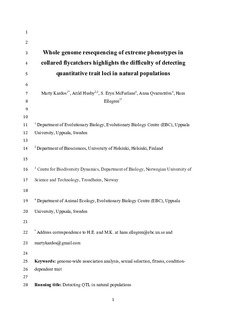| dc.contributor.author | Kardos, Marty | |
| dc.contributor.author | Husby, Arild | |
| dc.contributor.author | McFarlane, S. Eryn | |
| dc.contributor.author | Qvarnström, Anna | |
| dc.contributor.author | Ellegren, Hans | |
| dc.date.accessioned | 2017-10-30T08:57:37Z | |
| dc.date.available | 2017-10-30T08:57:37Z | |
| dc.date.created | 2016-12-12T11:20:04Z | |
| dc.date.issued | 2016 | |
| dc.identifier.citation | Molecular Ecology Resources. 2016, 16 (3), 727-741. | nb_NO |
| dc.identifier.issn | 1755-098X | |
| dc.identifier.uri | http://hdl.handle.net/11250/2462732 | |
| dc.description.abstract | Dissecting the genetic basis of phenotypic variation in natural populations is a long-standing goal in evolutionary biology. One open question is whether quantitative traits are determined only by large numbers of genes with small effects, or whether variation also exists in large-effect loci. We conducted genomewide association analyses of forehead patch size (a sexually selected trait) on 81 whole-genome-resequenced male collared flycatchers with extreme phenotypes, and on 415 males sampled independent of patch size and genotyped with a 50K SNP chip. No SNPs were genomewide statistically significantly associated with patch size. Simulation-based power analyses suggest that the power to detect large-effect loci responsible for 10% of phenotypic variance was <0.5 in the genome resequencing analysis, and <0.1 in the SNP chip analysis. Reducing the recombination by two-thirds relative to collared flycatchers modestly increased power. Tripling sample size increased power to >0.8 for resequencing of extreme phenotypes (N = 243), but power remained <0.2 for the 50K SNP chip analysis (N = 1245). At least 1 million SNPs were necessary to achieve power >0.8 when analysing 415 randomly sampled phenotypes. However, power of the 50K SNP chip to detect large-effect loci was nearly 0.8 in simulations with a small effective population size of 1500. These results suggest that reliably detecting large-effect trait loci in large natural populations will often require thousands of individuals and near complete sampling of the genome. Encouragingly, far fewer individuals and loci will often be sufficient to reliably detect large-effect loci in small populations with widespread strong linkage disequilibrium. | nb_NO |
| dc.language.iso | eng | nb_NO |
| dc.publisher | Wiley | nb_NO |
| dc.title | Whole-genome resequencing of extreme phenotypes in collared flycatchers highlights the difficulty of detecting quantitative trait loci in natural populations | nb_NO |
| dc.type | Journal article | nb_NO |
| dc.description.version | submittedVersion | nb_NO |
| dc.source.pagenumber | 727-741 | nb_NO |
| dc.source.volume | 16 | nb_NO |
| dc.source.journal | Molecular Ecology Resources | nb_NO |
| dc.source.issue | 3 | nb_NO |
| dc.identifier.doi | 10.1111/1755-0998.12498 | |
| dc.identifier.cristin | 1411325 | |
| dc.relation.project | Norges forskningsråd: 214553 | nb_NO |
| dc.description.localcode | This is the pre-peer reviewed version of the following article: [Whole-genome resequencing of extreme phenotypes in collared flycatchers highlights the difficulty of detecting quantitative trait loci in natural populations], which has been published in final form at [http://onlinelibrary.wiley.com/doi/10.1111/1755-0998.12498/abstract]. This article may be used for non-commercial purposes in accordance with Wiley Terms and Conditions for Self-Archiving. | nb_NO |
| cristin.unitcode | 194,66,10,0 | |
| cristin.unitname | Institutt for biologi | |
| cristin.ispublished | true | |
| cristin.fulltext | preprint | |
| cristin.qualitycode | 1 | |
